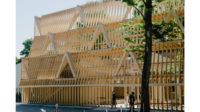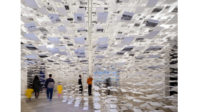Venice Biennale: National Accents












Venice, Italy
Our intrepid correspondent picks some of his favorite offerings from the national pavilions at this year's Biennale.
No one seems to gripe much anymore about how, in a globalized context, the very idea of national pavilions at an international exposition might seem anachronistic. Perhaps that’s because, for the time being at least, we’ve decided they’re not. Identity is a powerful thing, and the more than 50 national pavilions at this year’s Biennale—concentrated mostly in the Giardini, but also at the Arsenale and sites throughout town—remind us not only of our “Common Ground,” the Biennale’s theme, but also our differences.
The famously and perennially under-funded United States pavilion makes a strong showing this year with Spontaneous Interventions: Design Actions for the Common Good, under commissioner Cathy Lang Ho. The exhibition was organized by the Institute for Urban Design with curatorial assistance by Ned Cramer and David van der Leer. Scores of grassroots initiatives ranging from “guerilla bike lanes” to “urban repair squads” paint an optimistic picture of American civic engagement within a clever, interactive installation of banners, pulleys, and counterweights by Brooklyn design firm Freecell.
A general ambivalence about government’s role in architecture (or at least an awareness of its limits) can also be seen in pavilions such as Romania’s and Hong Kong’s—though not far away, in the Giardini’s Central Pavilion, Rem Koolhaas’s OMA once again thumbs its nose at conventional wisdom with Public Works: Architecture by Civil Servants, which commends buildings designed by “anonymous” European bureaucrats in the 1960s and ‘70s.
Russia goes over-the-top with i-city, a dizzying environment of backlit QR codes curated by architects Sergei Tchoban and Sergey Kuznetsov; by scanning the codes with a tablet computer, one can learn about the Skolkovo Innovation Center, a massive Silicon Valley-in-the-making and pet project of the state. The Dutch, meanwhile, prove to be popular with Re-Set, an understated installation of mechanized curtains by designer Petra Blaise. The Brits sent 10 architect teams to other parts of the world to see what they could learn, while the Toyo Ito-curated Japan pavilion features a temporary housing project for an area hit hard by that country’s earthquake and tsunami last year.
For at least the third time in a row, the Polish pavilion stands out, this year with an impressive sound sculpture by Katarzyna Krakowiak that amplifies the ambient noise of its building. Entitled Making the walls quake as if they were dilating with the secret knowledge of great powers, the piece was curated by Michal Libera. The Poles are doing something right. Others come out a bit looser. Proving the adage that tough times call for good times, the Spanish are presenting Spainlab, a raucous environment curated by Antón García-Abril and Débora Mesa that features moiré walls, flying models, aerial hydroponic gardens and a walk-in glass dome topped by what looked like a giant hat. It's hard to tell what it's all about. But at least it seems the Spanish are having fun.











